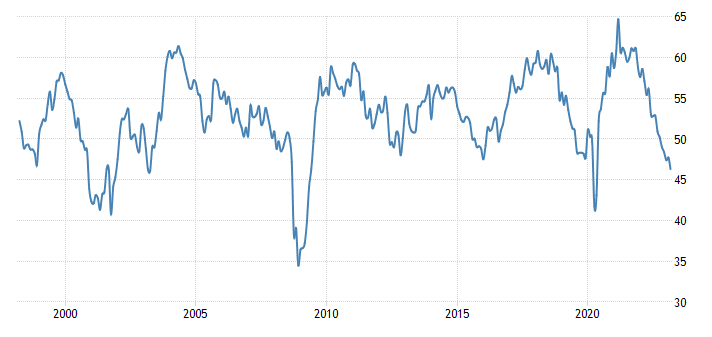Overnight, the final value of the Markit manufacturing PMI in the United States recorded 49.2 in March, slightly lower than market expectations and the previous value of 49.3. The March manufacturing PMI announced by the more important ISM fell from 47.7 to 46.3 (the lowest level since the pandemic in 2020), which was lower than market expectations of 47.5. The sub-data show that, except for the output index, which rose moderately to 47.8 (previously 47.3), other indicators have declined, including the price payment index (49.2, previously 51.3), employment index (46.9, previously 49.1), inventory index (47.5, previously 50.1) and new orders index (44.3, previously 47.0).
Figure 1: US ISM Manufacturing PMI. Source:Trading Economics
Also, the S&P Global US Manufacturing PMI recorded 49.2 in March, slightly higher than February’s 47.3. That was based on output rising for the first time since October last year, prompting the sector to contract at its slowest pace in a five-month recession. However, demand is expected to remain subdued with rising interest rates and inflationary pressures, with business confidence slipping to a three-month low.
Figure 2: S&P Global US Manufacturing PMI. Source:Trading Economics
It is worth noting that since the PMI began in the 1960s, the number of times this indicator has been equal to or lower than the current level (<50) has been 16, and the US economy has fallen into recession on 12 of those occasions. This means that from the perspective of past historical data performance, the prediction success rate of this indicator is as high as 75%.
With OPEC+ unexpectedly announcing a production cut of 1.649 million barrels per day next month, the market rekindled concerns about long-term inflation and uncertainty about the Fed’s response, and the US dollar index plunged below the 102 level on the first trading day of the week, and has breached 105.50 today to post a new 42-day low. Fed’s Bullard pointed out that it is “inconclusive” whether OPEC+’s move will have a long-lasting impact, but he expects inflation to be more sticky. The Federal Reserve has been condemned by all parties after the bank failure. Although this is unlikely to lead to an early shift in the Fed’s policy in the short term, the Committee will struggle and be more cautious in the process of implementation.
Figure 3: Australian interest rates. Source: Trading Economics
During today’s Asian trading session, the Reserve Bank of Australia announced its interest rate decision until April 4. The central bank kept its policy rate unchanged at 3.6%, in line with market expectations. This is the first time the central bank has paused rate hikes since raising rates in May last year. In a statement, the Reserve Bank of Australia pointed out that medium-term inflation expectations have stabilized, but the labor market is still very tight, and the Bank “will be alert to the risk of spiraling prices and wages.” The committee also stated that Australia’s economic growth has slowed down, and it will continue to pay attention to employment, price indexes and the global economy in the future to assess the specific timing, extent and prospects of interest rate hikes.
Technical Analysis:

AUDUSD, H4
The pair pulled back lower after RBA rate decision, currently under pressure at key resistance at 0.6790 (FR 38.2% from year-to-date peak to trough). Should the price remain under pressure below this resistance, its recent high (0.67926) will be the second higher high in the ascending channel structure. A pullback would encourage bears to test the first higher high at 0.6758, then 0.6700 (FR 23.6%) and the dynamic support of SMA-100. On the contrary, if the exchange rate rises further and breaks through 0.6790 and the top line of the upward channel, it will mean that the structure is broken, and the next resistance is seen at 0.6860 (FR 50.0%) and 0.6930 (FR 61.8%).
Larince Zhang
Market Analyst
Click here to access our Economic Calendar
Disclaimer: This material is provided as a general marketing communication for information purposes only and does not constitute an independent investment research. Nothing in this communication contains, or should be considered as containing, an investment advice or an investment recommendation or a solicitation for the purpose of buying or selling of any financial instrument. All information provided is gathered from reputable sources and any information containing an indication of past performance is not a guarantee or reliable indicator of future performance. Users acknowledge that any investment in Leveraged Products is characterized by a certain degree of uncertainty and that any investment of this nature involves a high level of risk for which the users are solely responsible and liable. We assume no liability for any loss arising from any investment made based on the information provided in this communication. This communication must not be reproduced or further distributed without our prior written permission.






















